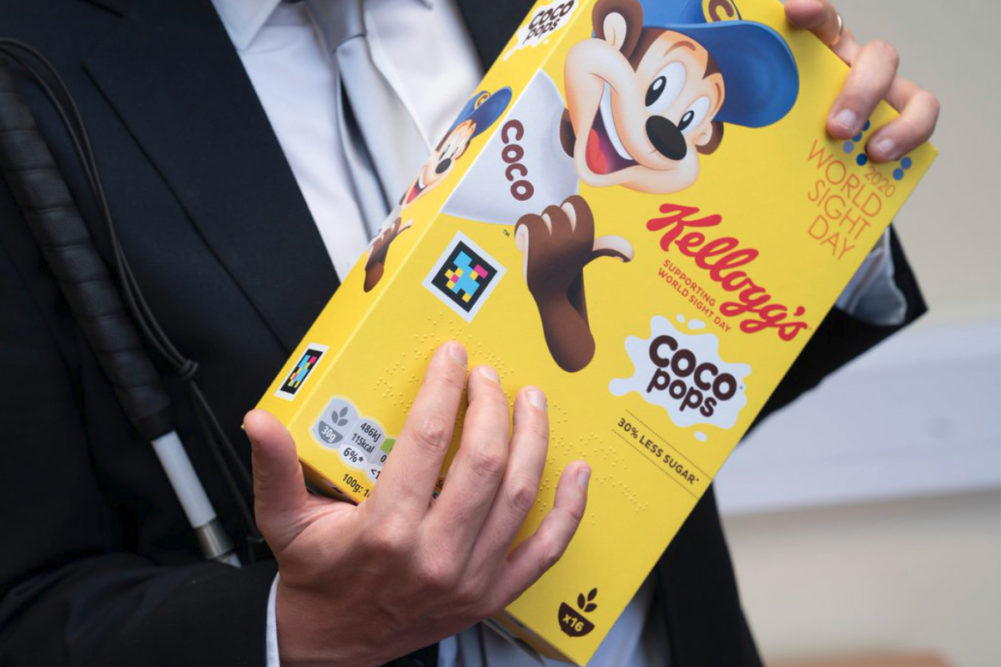LONDON — Kellogg Co. is set to make a ground-breaking change to its cereal boxes in the United Kingdom, adding technology that will allow blind and partially sighted people to access important information such as allergen details.
In partnership with NaviLens, Kellogg in 2022 will begin packaging cereal in boxes that allow a smartphone to easily detect a unique on-pack code and play back labeling information to the consumer with sight loss. The NaviLens technology includes high-contrasting colored squares on a black background. According to Kellogg, consumers do not need to know exactly where the code is located to scan it. Using the free NaviLens App, consumers can pick up the on-pack code from up to 10 feet away from the cereal box. Once the code is detected, consumers have the option to have the ingredients, allergen and recycling information read aloud to them — as well as reading it on their device using accessibility tools.
Kellogg said the first accessible boxes of Special K will begin appearing on store shelves in the United Kingdom in January 2022, with all other cereal brands transitioning to the new packaging throughout the year.
The idea for the accessible boxes followed a 2019 meeting between representatives of Kellogg and children at St. Vincent’s, a specialist school in Liverpool for children with sensory impairment. It was the pupil’s insight that inspired the business to look for solutions. Subsequently, Kellogg initiated a successful UK trial last year in partnership with Co-op, on Kellogg’s Coco Pops boxes. Evaluation of the pilot by charity Royal National Institute of Blind People (RNIB) showed that 97% of the participants agreed that they would like to see more of these accessibility features available on grocery packaging in the future.
The NaviLens technology is currently used in Spain across Barcelona, Madrid and Murcia city transport systems, making the cities easier to navigate for thousands of visually impaired citizens.
“Over two million people in the UK live with sight loss and are unable to simply read the information on our cereal boxes,” said Chris Silcock, head of Kellogg UK. “As a company focused on equity, diversity and inclusion we believe that everyone should be able to access important and useful information about the food that we sell. That’s why, starting next year, we are adding new technology to all of our cereal boxes. I am proud that Kellogg will be the first company in the world to use NaviLens on packaging. We know it’s important that all packaging is accessible for the blind community to enable them to make shopping easier, so we will share our experience with other brands who want to learn more.”
Javier Pita, chief executive officer of NaviLens, the startup company that created the technology, added, “The incorporation of the NaviLens codes onto food packaging is a positive step toward a more inclusive and accessible shopping experience for the visually impaired. This allows people with sight loss to shop more independently and make their own food choices.”
Marc Powell, strategic accessibility lead at RNIB, called the announcement “a real game changer” within the packaging world.
“It marks a significant step-change in how big brands can put accessibility at the forefront of design and packaging decisions and be a catalyst for change,” Mr. Powell said. “Important information on packaging can often be in very small print, making it difficult or impossible for people with sight loss to read. Changes like this can provide blind and partially sighted people with vital information for the very first time, giving us the same freedom, independence and choice as sighted customers. Designing packaging so that it works for everyone makes complete sense and we hope that other brands will follow Kellogg’s lead in making packaging information more accessible.”






